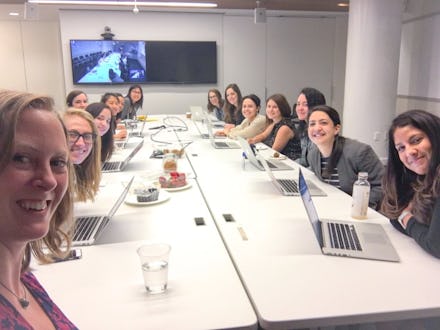This Tweet From a 'Huffington Post' Editor Shows the Problem With White Feminism

On Friday, Huffington Post Executive Editor Liz Heron tweeted the below photo of an editors' meeting. It was intended as a humble brag — well, maybe not so humble — about gender diversity among the ranks of editors at the company.
(Disclosure: I used to work at the Huffington Post and was involved in the effort to unionize the newsroom.)
What Twitter users noticed immediately was not how many women appeared in the photo, but how few people of color seemed to be included:
On the other hand, Fox News Insider used the opportunity to play the "reverse discrimination" card, decrying the lack of men in the photo. A handful of users on Twitter sounded off on the same note:
Another user on Twitter pointed out that the photo does feature a handful of Asian editors:
Race is a complex thing. Without asking each of the editors in the photo about their racial and ethnic identity, it's impossible to truly pinpoint the racial makeup of editors at the company. To give credit where it's due, it's also clear from Heron's tweet that she cares about representation among the Huffington Post's ranks. A source said the photo was taken at the beginning of the meeting before other editors, including men, joined. Another source at the company further pointed out that five of the women in the photo identify as minorities.*
But racial diversity at the company was one of the key issues union supporters raised during the organizing drive in 2015.
"[The Huffington Post] has taken a strong editorial stance in favor of diversity, but this diversity is not reflected among the staff," one pro-union employee told Poynter in May 2015. "We would like to formalize our commitment to inclusivity in hiring, and keep HuffPost accountable to that commitment."
Diversity isn't only a problem at the Huffington Post. According to the American Society of News Editors' annual survey, minorities make up 12.8 percent of newsrooms; the U.S. Census Bureau says minorities account for 37.9 percent of the total U.S. population.
ASNE also found the while 63 percent of newsrooms have women in the top three leadership positions, only 12 percent of participating organizations had racial/ethnic minorities in leadership. What's more, the percentage of newsrooms with minorities in leadership dropped 3 points from 2014 to 2015.
Corporate America long ago signed on to the idea that a diverse staff makes better decisions. But diversity is even more important in journalism than at a company that, say, manufactures widgets. Journalists are in the business of telling stories, and having folks from diverse walks of life on staff helps newsrooms tell not only a wider range of stories from minority communities, but fuller ones.
But even if you don't buy the idea that diversity enriches the editorial process, one can appreciate that, at the very least, it stops you from making dumb mistakes. When people of color are in the room — and, just as important, empowered to speak their mind — they can tell you it's a bad idea to publish a video where black people repeat stereotypes about African Americans that are typically voiced by whites. Or in this case, that there seems to be no people of color in the photo you're about to tweet.
The Huffington Post declined to comment for this story. Liz Heron did not respond to Mic's request for comment.
*UPDATE, May 24, 2016 2:31 p.m.: This post has been updated with comment from a source at the company.